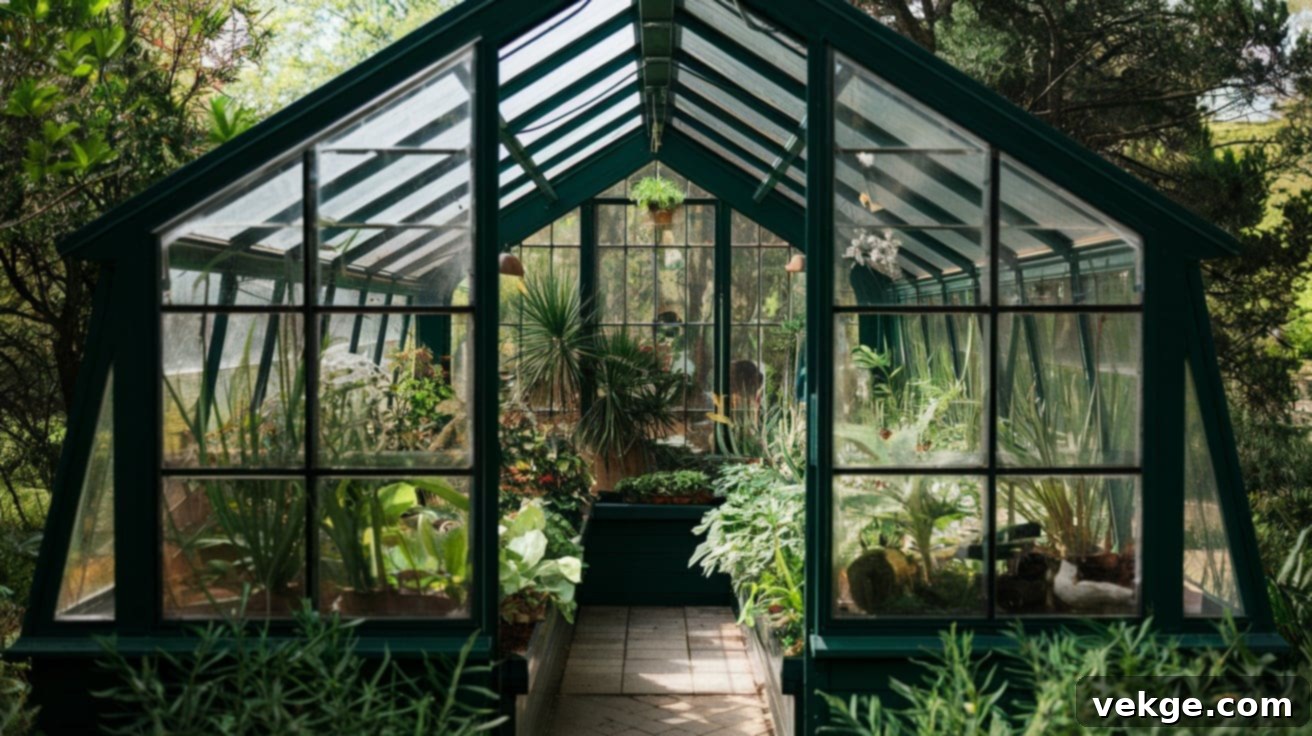Transform Your Garden: The Ultimate Guide to Greenhouses for Year-Round Growing Success
A greenhouse is far more than just a structure; it’s a dynamic, thriving ecosystem that revolutionizes your gardening experience. It extends your growing season far beyond traditional limits and acts as an indispensable shield, protecting your delicate plants from the unpredictable whims of weather, from harsh frosts to scorching sun.
Whether your passion lies in cultivating vibrant flowers, producing fresh vegetables, or nurturing exotic plants that demand specific environmental conditions, a greenhouse provides the quintessential environment. It maintains optimal temperatures, humidity, and light levels, ensuring healthy, vigorous growth throughout the entire year, regardless of external climate challenges.
Beyond its undeniable practical benefits, a well-chosen greenhouse significantly enhances the aesthetic appeal of your outdoor space. It transforms into a serene, personal retreat – a place where you can immerse yourself in the natural world, nurture your botanical treasures, and unwind amidst the calming greenery. From cleverly designed compact cold frames perfect for small urban gardens to majestic Victorian-style glasshouses that become the focal point of a grand estate, there’s a greenhouse solution tailored to every available space, budget, and gardening aspiration.
If you’re eager to elevate your gardening journey and unlock a world of possibilities, this comprehensive guide will walk you through the diverse types, essential materials, and innovative features that make greenhouses a truly valuable and rewarding investment. Discover how they contribute to beauty, promote sustainability, and boost the productivity of your garden, offering endless opportunities for growth and enjoyment.
Types of Greenhouses for Every Space and Budget
Standalone Structures
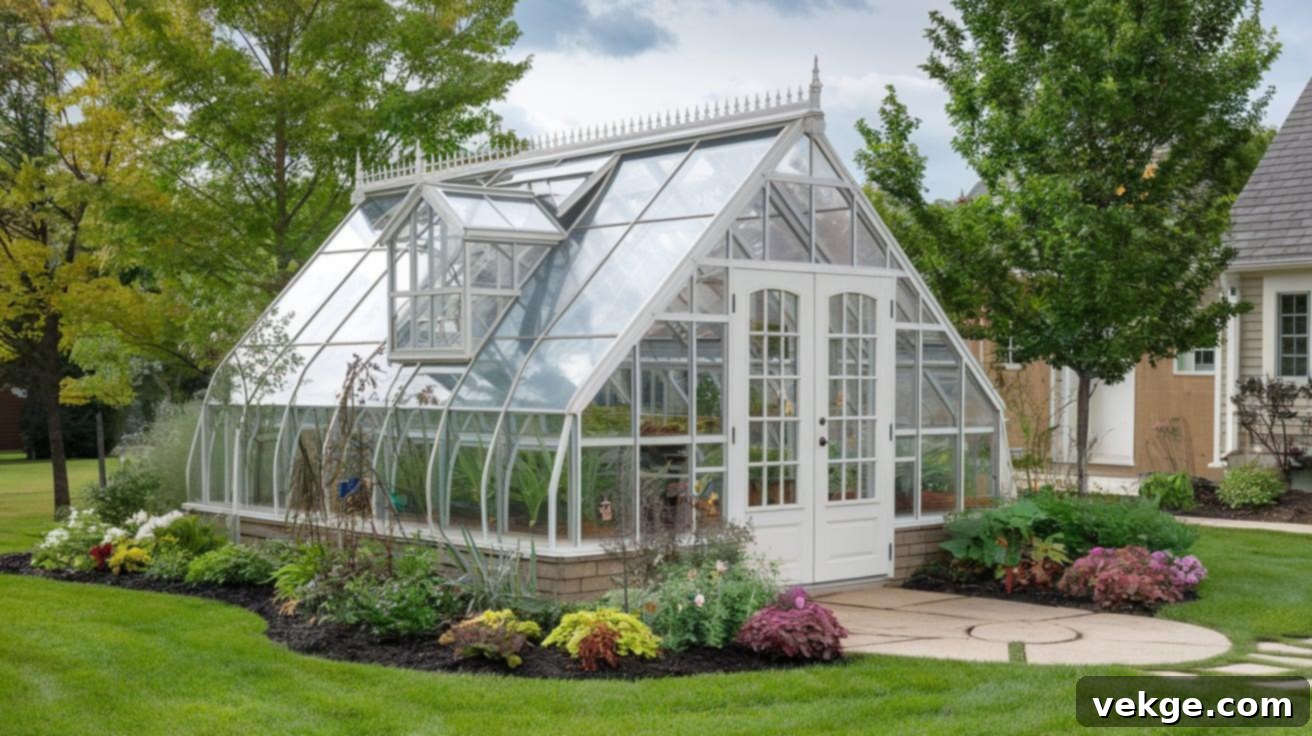
Standalone greenhouses represent the quintessential form, offering the ultimate flexibility and the most extensive growing options for a wide array of plants. These are full, independent buildings that come in an impressive variety of sizes, shapes, and architectural styles, allowing gardeners to create a truly dedicated growing environment. From compact models suitable for a suburban backyard to expansive commercial-grade structures, they provide ample space for benches, shelves, and even dedicated work areas.
Many standalone designs feature peaked roofs, expertly engineered to shed heavy snow loads with ease, making them ideal for colder climates. Other popular configurations include dome shapes, which excel at providing exceptional light coverage from all angles, ensuring every plant receives its share of sunshine. The classic steel-and-glass model, with its elegant lines and robust construction, creates a timeless aesthetic that complements any garden. These versatile structures can be strategically placed anywhere on your property that boasts optimal sun exposure throughout the day. Furthermore, many high-quality standalone greenhouses come equipped with built-in shelving, ventilation systems, and spacious work areas, maximizing their utility. While they do require a larger footprint, they offer unparalleled room for growth, allowing you to cultivate a diverse and thriving plant collection.
Lean-to Designs for Limited Space
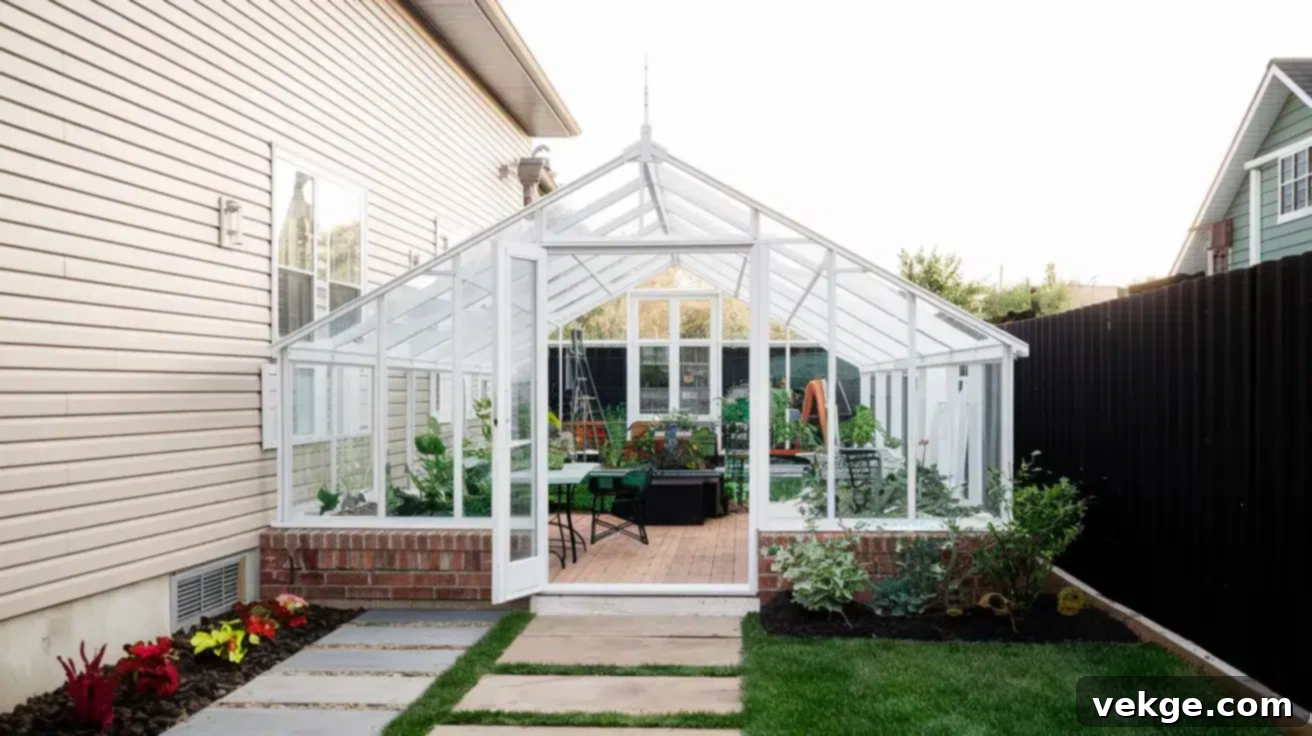
For gardeners with limited space, lean-to greenhouses offer an ingenious and efficient solution. These designs are specifically crafted to attach seamlessly to an existing wall of your home, garage, shed, or any other robust building. By utilizing one of the building’s exterior walls as a structural component, lean-tos effectively save valuable yard space while still providing a substantial and functional growing area. This clever design reduces overall building costs, as fewer materials are needed for the structure itself.
A significant advantage of lean-to greenhouses is their enhanced heating efficiency. Sharing a wall with a heated structure, such as your home, means that some residual heat can radiate into the greenhouse, reducing the energy required for supplemental heating, especially during cooler months. This makes them an economical choice for year-round growing. They are particularly well-suited for small yards, patios, or tight urban spaces where a standalone greenhouse would be impractical, allowing urban gardeners to enjoy the benefits of a greenhouse without sacrificing precious outdoor real estate.
Cold Frames vs. Full Greenhouses

-
Structure: At their core, cold frames are compact, box-like structures, typically sitting low to the ground and topped with transparent materials like glass or plastic. Their modest size makes them ideal for small gardens or specific plant needs, primarily offering protection. In stark contrast, full greenhouses are substantial, walk-in enclosed buildings designed to accommodate a wider variety of plants and provide ample space for gardeners to work within. This fundamental difference in scale dictates their primary applications and the range of plants they can support.
-
Heating: Cold frames rely entirely on passive solar heat, trapping warmth from the sun during the day and providing a slight insulation boost at night. They are not designed for active heating. Conversely, full greenhouses are often equipped with sophisticated heating systems, which may include electricity, natural gas, or propane, allowing gardeners to precisely control the internal temperature and extend the growing season even through the harshest winters, accommodating tropical or heat-loving plants.
-
Space: Cold frames are inherently space-efficient, occupying minimal room and easily fitting into small gardens, balconies, or even tucked away in a corner. They are perfect for urban dwellers or those with limited outdoor areas. Full greenhouses, on the other hand, demand a dedicated and often substantial footprint. They require careful planning for placement within a garden and often become a prominent feature of the landscape.
-
Function: Cold frames are invaluable tools for cool-weather crops, extending the harvest of greens, and, crucially, for hardening off seedlings before transplanting them outdoors. They offer a transitional environment. Full greenhouses provide a much broader functional scope, supporting the year-round growth of a vast array of plants, from seed propagation to mature fruiting plants, allowing for complete control over the growing environment.
-
Installation: Many cold frames are designed to sit partly below ground level, leveraging the earth’s natural insulation to maintain more stable temperatures. They are often portable or easily assembled. Full greenhouses, conversely, are typically permanent or semi-permanent freestanding structures, or they are securely attached to an existing building, requiring a more involved installation process and a solid foundation.
Upcycled Window Greenhouses
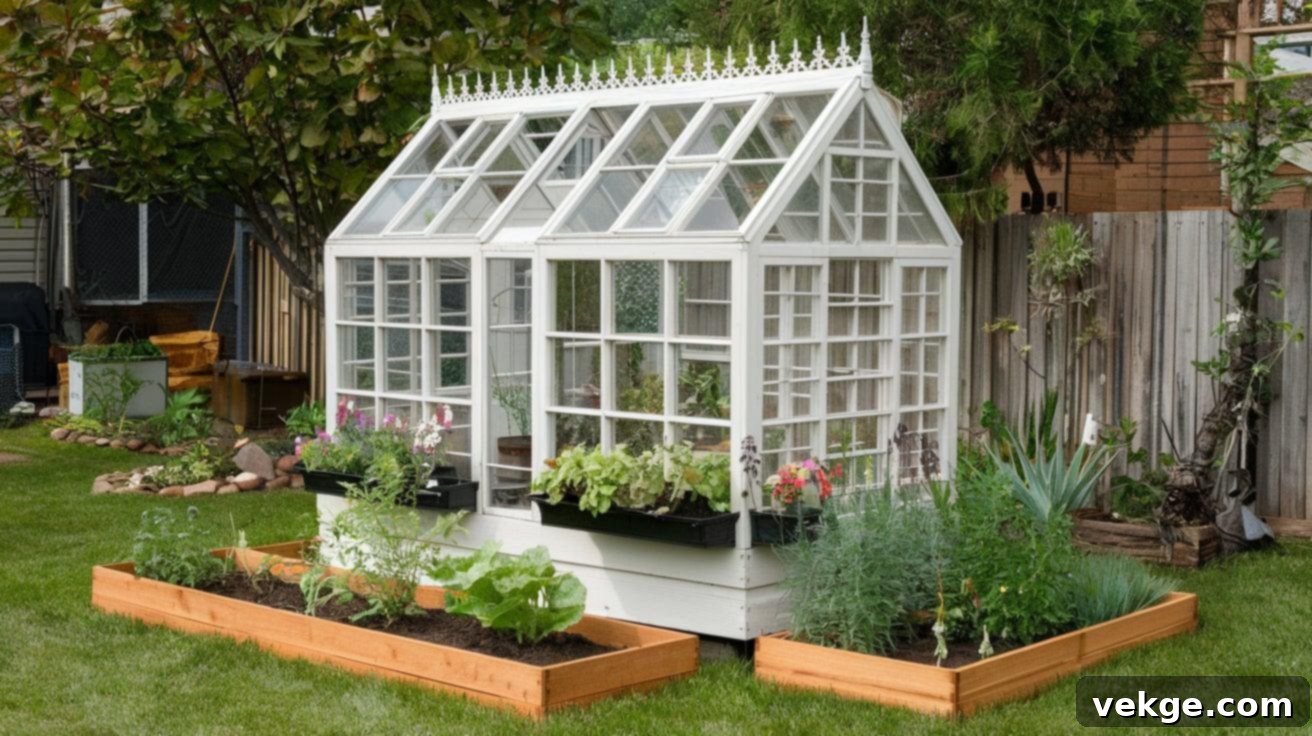
For the eco-conscious gardener or DIY enthusiast, old windows offer a fantastic opportunity to create a charming and incredibly unique upcycled greenhouse. These budget-friendly projects not only provide an effective growing space but also add distinct character and a touch of rustic charm to your yard or garden. The beauty of an upcycled window greenhouse lies in its individuality; each one looks different, reflecting the specific windows you manage to acquire, whether from salvage yards, renovation projects, or antique shops.
The main challenge, and part of the creative process, involves sourcing windows of similar sizes or complementary shapes to achieve a balanced and structurally sound design. While this option significantly reduces the cost compared to purchasing a new, prefabricated structure, it does require basic carpentry skills to construct a sturdy frame that can securely hold the windows. The reward is a truly one-of-a-kind growing space that is rich in character and tells its own story, offering a sustainable and aesthetically pleasing solution for your gardening needs.
Classic Greenhouse Designs
English Garden Style
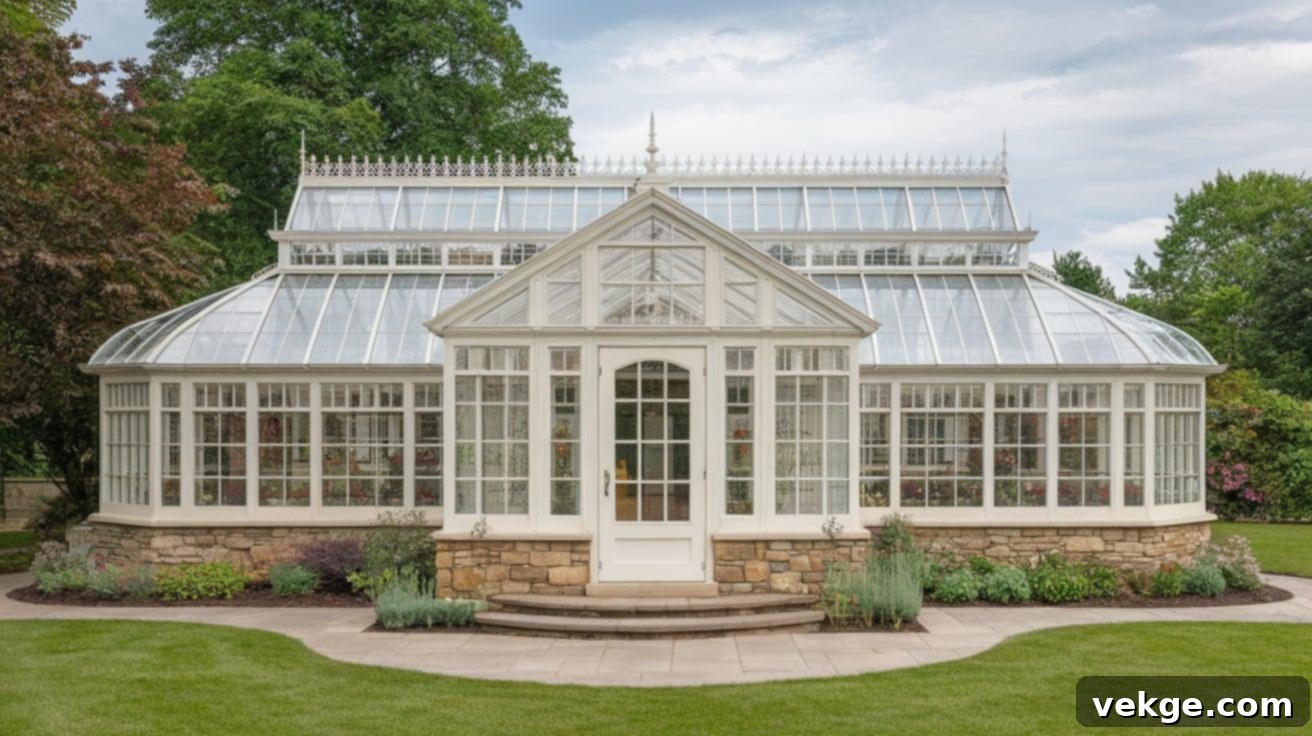
English garden greenhouses embody timeless elegance and sophisticated charm, often showcasing exquisite architectural details that elevate them beyond mere functional structures. These designs are renowned for ornamental roof cresting, intricate finials, and decorative ridge caps that draw the eye upward, adding a touch of grandeur to the roofline. The classic white or dark green frame, meticulously crafted with numerous small glass panels, creates a bright, airy, and inviting feel, maximizing light penetration while maintaining a delicate aesthetic.
Many English styles incorporate sturdy stone or brick bases, which not only provide exceptional stability and insulation but also contribute significantly to their visual appeal and classic garden integration. The designs frequently feature a prominent central door, often with gracefully arched tops, flanked by an abundance of windows on all sides, ensuring panoramic views and consistent light. English garden greenhouses masterfully blend formal structure with practical growing space, making them perfectly suited for traditional garden settings where they serve as a magnificent focal point and a true testament to horticultural artistry.
Modern Minimalist

Modern minimalist greenhouse designs are characterized by their unwavering focus on clean lines, expansive glass surfaces, and open, uncluttered spaces. This design philosophy prioritizes simplicity and functionality, often utilizing fewer, yet stronger, frame pieces to maximize the amount of glass and, consequently, the influx of natural light. Metal frames, typically finished in sleek black, charcoal, or other dark colors, create a strong, contemporary visual impact that blends seamlessly with modern architecture.
These cutting-edge designs prioritize functionality and efficiency, often integrating smart ventilation and climate control systems that are discreetly hidden or seamlessly incorporated. Many feature innovative sliding or folding doors, which not only save space but also offer versatile access and enhanced airflow when needed. The inherently simple yet sophisticated style of modern minimalist greenhouses makes them perfectly suited for updated garden spaces and contemporary home designs, where they blend in harmoniously without ever looking out of place. They embody a belief that beauty lies in efficiency and understated elegance, providing a highly functional and aesthetically pleasing growing environment.
Victorian Inspired
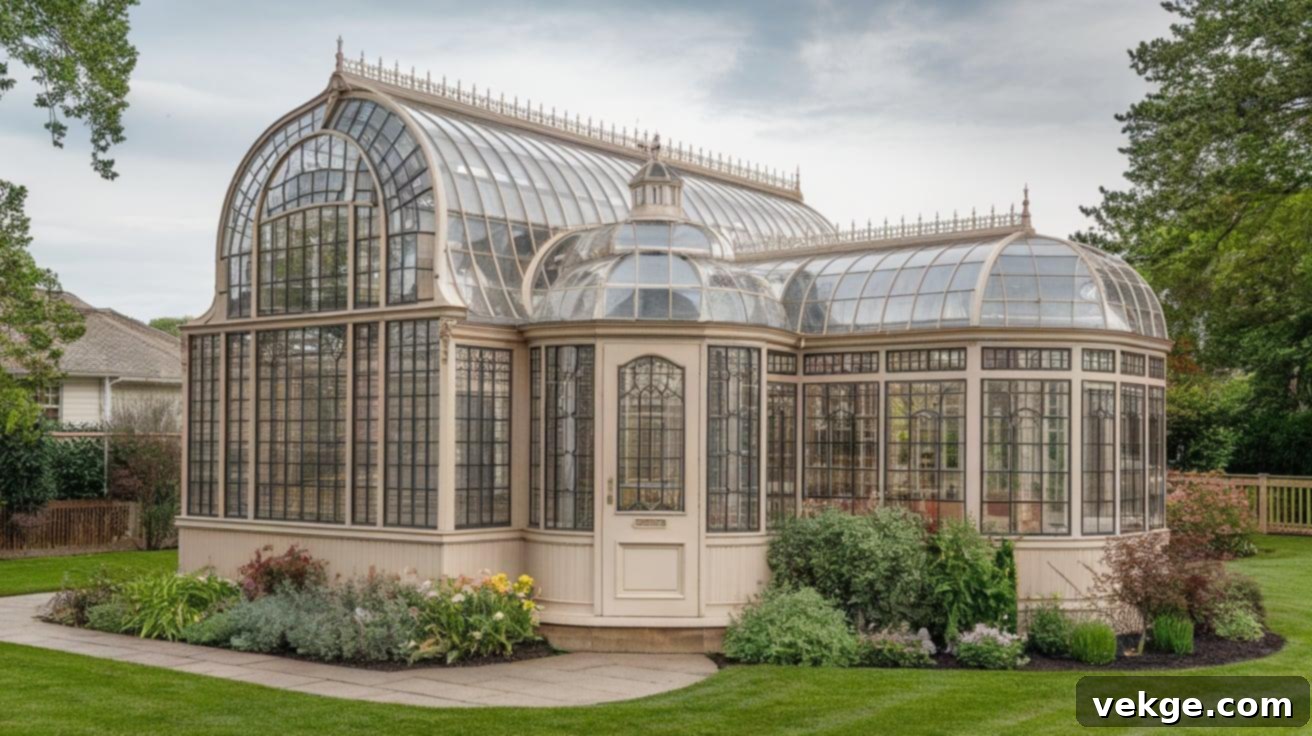
Victorian-inspired greenhouses transport you back to the opulent charm of a bygone era, exuding a sense of historical grandeur and intricate beauty. These magnificent structures are distinguished by their elaborate detailing, which often includes decorative trim work, ornate cresting, and gracefully curved glass sections that create a truly distinctive silhouette. A hallmark of Victorian design is the use of glass that extends nearly to the ground, allowing for maximum light exposure and an immersive connection to the plants within.
The designs frequently incorporate a multitude of small panes of glass arranged in a delicate grid pattern, adding to their intricate appeal. Some grander Victorian models feature a central dome or a towering roof peak, adding significant height and architectural drama. These greenhouses are designed to make a powerful style statement, transforming any garden into a showcase. They often become the undisputed main focus of the outdoor space, serving as a stunning backdrop for formal gardens or complementing the architecture of classic, period homes with their rich, ornate details.
Cottage Garden Greenhouse

Cottage-style greenhouses evoke a sense of warmth, coziness, and homespun charm, perfectly blending into a relaxed, informal garden setting. These delightful structures often mix natural materials, such as rustic wood frames paired with classic glass panels, creating an inviting and organic aesthetic. Many designs thoughtfully include charming details like exterior window boxes brimming with flowers or integrated supports for climbing plants, further blurring the lines between the greenhouse and the garden itself.
These designs harmonize beautifully with less formal garden layouts, celebrating a natural, slightly wild aesthetic where plants are allowed to spill and intertwine. The cottage style is inherently adaptable, making it perfect for garden spaces that gracefully evolve and change with the seasons, reflecting the ebb and flow of nature. Some cottage greenhouses even incorporate small porches or covered entry areas, enhancing their resemblance to miniature garden homes rather than strictly utilitarian plant spaces. They create a welcoming and enchanting spot that not only shelters your plants but also draws you in, inviting you to relax and truly become part of the garden experience.
Smart Features, Materials, and Solutions
Proper Ventilation Systems
Maintaining good airflow is paramount for ensuring the health and vitality of your greenhouse plants. Robust ventilation systems are crucial for managing temperature, controlling humidity, and facilitating the necessary exchange of gases. Roof vents, strategically placed at the highest point, allow hot, stagnant air to escape, preventing overheating, especially on sunny days. Simultaneously, plants require a constant supply of fresh carbon dioxide for efficient photosynthesis and growth.
Side vents, positioned lower down, work in conjunction with roof vents to create natural cross-breezes. This active air movement is vital for cutting down excessive humidity, which is a common culprit for fungal diseases and pest outbreaks. For maximum convenience and efficiency, automatic vents utilize heat-sensitive waxes or bimetallic strips to open and close passively based on temperature, ensuring optimal conditions even when you’re away. Manual vents, while more budget-friendly, require daily checks and adjustments. The most effective strategy often involves using both high (roof) and low (side) vents to create superior air exchange. Without consistent and adequate air movement, plants are highly susceptible to issues like mold, mildew, and various plant diseases, compromising your entire crop.
Water and Irrigation Solutions
Easy and efficient water access is a cornerstone of successful greenhouse gardening. For smaller setups or those with fewer plants, traditional hoses and watering cans can suffice, offering a hands-on approach. However, for larger greenhouses or busy gardeners, automated irrigation systems are invaluable. Drip irrigation on timers, for example, delivers water directly to the plant roots, minimizing waste and ensuring consistent hydration, even during vacations.
Integrating a small sink inside the greenhouse significantly reduces trips to the house, making tasks like potting, washing tools, and cleaning produce much more convenient. For an eco-friendly and cost-effective solution, installing rain barrels to collect rainwater from the greenhouse roof is highly recommended. Some advanced designs even include integrated gutter systems that channel rainwater directly into large storage tanks. Your specific water needs will naturally fluctuate with the seasons, the types of plants you’re growing, and the climate. Investing in the right irrigation setup not only saves considerable time and effort but also ensures your plants receive the precise amount of water they need to thrive.
Temperature Control Options
Effective temperature management is key to maximizing your greenhouse’s potential and significantly extending your growing seasons. Simple, passive options include strategically opening vents when temperatures rise and closing them when it gets cool, a method that requires regular monitoring. For year-round cultivation, especially in colder climates, supplemental heaters (electric, gas, or propane) are essential for maintaining warmth during winter months, allowing you to grow frost-sensitive plants.
Conversely, during hot summers, shade cloth can be deployed externally to significantly reduce heat gain while still allowing beneficial light to filter through. Thermostats can automate temperature control, activating fans for cooling or heaters for warmth as needed. Thermal mass solutions, such as placing large barrels of water or dark-colored stones inside, absorb heat during the day and slowly release it at night, helping to stabilize temperatures naturally. The ideal temperature control system will depend heavily on your specific growing goals, such as cultivating tropical plants that demand consistent warmth versus hardy vegetables that tolerate cooler conditions.
Glass vs. Plastic Consideration
The choice between glass and plastic glazing is one of the most critical decisions for a new greenhouse, impacting light transmission, insulation, durability, and budget. Glass offers superior light transmission, allowing nearly 90% of available light to reach your plants, and maintains its clarity without yellowing over time, providing a classic, premium aesthetic. However, glass is generally more expensive and heavier to install.
Plastic glazing, including polycarbonate and polyethylene films, is significantly more affordable and easier to install, making it a popular choice for budget-conscious growers and DIY projects. Polycarbonate panels, particularly twin-wall or multi-wall varieties, offer excellent insulation properties due to their air pockets and are highly resistant to breaking, making them a safer option in areas prone to hail or strong winds. While glass provides a crisp, clear view and a timeless look, plastic allows for more curved and flexible designs that shed snow effectively. Tempered glass is stronger than standard glass but still susceptible to breakage during severe storms, though it shatters into safer, rounded pieces. The best choice ultimately depends on your climate, available budget, desired aesthetic, and the specific needs of the plants you plan to grow.
Framing Material Options
The choice of framing material profoundly affects the durability, appearance, and maintenance requirements of your greenhouse. Aluminum frames are incredibly popular due to their inherent resistance to rust and corrosion, requiring virtually no painting or ongoing maintenance. They are lightweight, strong, and can be powder-coated in various colors for aesthetic appeal.
Wood frames, often made from cedar or redwood, offer a beautiful, natural aesthetic that blends seamlessly into garden settings. They provide better insulation than metal frames and are pleasant to work with, but require regular sealing or painting to prevent rot and insect damage. Steel offers exceptional strength, making it ideal for larger, more robust structures that need to withstand heavy loads, but it must be properly treated or galvanized to prevent rust. PVC pipe can be used for very inexpensive, temporary, or small-scale greenhouse frames, though it lacks the durability and aesthetic appeal of other materials. Building codes in some regions may dictate specific material requirements. When choosing, consider the balance between initial cost, expected lifespan, maintenance commitment, and overall aesthetic appeal that aligns with your garden’s style.
Decorative Features and Lighting for Your Greenhouse
Ornamental Roof Details
Adding ornamental roof details can transform a functional greenhouse into a stunning architectural feature. Small finials, decorative cresting, or weather vanes placed on roof peaks lend an air of traditional charm and sophistication. Fancy trim along the eaves or gables creates a polished, finished look, enhancing the greenhouse’s visual appeal. Special etched or textured glass panels can create intriguing sun patterns on the interior, while colored glass inserts can cast vibrant rainbow effects, adding a magical touch to the space.
Decorative metal designs, such as elaborate brackets or scrolled accents, can further enhance roof ends. Copper elements, like decorative gutters or downspouts, will beautifully develop a unique green patina over time, adding character. Replacing plain gutters with decorative chain guides offers both function and a unique visual element. Even a classic wind indicator or a whimsical garden finial serves both a practical purpose and adds a delightful stylistic accent.
Wall Treatments and Skirting Options
The base and walls of your greenhouse offer ample opportunities for both functional improvement and aesthetic enhancement. Low rock bases provide natural texture, exceptional strength, and added insulation, helping to stabilize internal temperatures. Decorative clay blocks or bricks can add a touch of color and robust protection against ground-level splashback and pests. Brightly painted trim or window sills can personalize your space, making it truly yours.
Incorporating grid panels or trellises on exterior walls provides support for climbing plants, blurring the lines between the greenhouse structure and the living garden. Wooden strips or battens can be used to neatly cover corner joints, adding a refined finish. External plant boxes attached to the base extend your growing area and allow for beautiful floral displays. Contrasting colors for the base and upper structure can create strong visual interest, while decorative tiles around the entryway can create a warm and welcoming impression for visitors.
Interior Fixtures Worth Adding
Thoughtful interior fixtures can significantly enhance the functionality and comfort of your greenhouse. Installing ceiling hooks allows you to maximize vertical plant space with hanging baskets or air plants, freeing up bench surfaces. Old gardening tools, carefully cleaned and arranged, can become charming wall art, celebrating the craft. Small, delicate bells hung near a door or window can add pleasant, subtle sounds as breezes pass through. Vintage cans, repurposed as planters or storage, create whimsical shelf displays.
For a touch of sparkle, strategically placed crystals can split sunlight into captivating rainbows that dance across your plants and walls. Solar-powered lights provide soft illumination after sunset, extending your enjoyment into the evening. Rustic plant markers or engraved labels not only identify your plants but also add to the cottage or natural aesthetic. Most importantly, a comfortable seating area – even a simple bench – invites you to pause, relax, and truly enjoy the tranquil ambiance of your thriving indoor garden.
Plant Display Methods
Creative plant display methods are essential for both maximizing space and showcasing your botanical collection. Stepped shelves or tiered benches create height variation, allowing different plants to receive optimal light and adding visual depth. Hanging pots and baskets are excellent for utilizing vertical space, especially for trailing plants or delicate ferns, keeping them off crowded surfaces.
Spiral plant stands are perfect for fitting a variety of pots into tight corners, making efficient use of every inch. Tiered units are ideal for highlighting specific collections, such as succulents or orchids, allowing each specimen to be admired individually. Window shelves specifically capture direct sunlight, benefiting light-loving seedlings or small plants. Rolling carts offer incredible flexibility, allowing you to easily move plants for watering, light exposure, or simply to rearrange your layout. Wall-mounted planters or shelves free up valuable bench space, while trellises and obelisks provide crucial support for vertical growth, transforming walls into living tapestries of vines and climbers.
Greenhouse Lighting Options for Day and Night
Natural Light Maximization
Maximizing natural light is fundamental to greenhouse success. Opting for clear glazing panels, whether glass or high-quality polycarbonate, ensures the highest possible transmission of sunlight. Strategic placement of the greenhouse, ideally facing south in most northern hemisphere climates, captures the maximum amount of winter sun, which is crucial for continued growth. Painting interior walls and benches white or using reflective surfaces helps bounce light into darker corners and underneath plant foliage, promoting even growth.
During intense summer months, removable shade cloth can be draped externally to control excessive heat and prevent scorching, yet still allowing beneficial diffused light to pass through. Using bubbled or diffused glass/plastic spreads light more evenly, reducing hot spots. Reflective ground covers or white gravel outside the greenhouse can bounce additional light upward. Regularly cleaning the glazing is vital; dirty glass can reduce light transmission by up to 30%, directly impacting plant health. Finally, trimming any nearby trees or shrubs that cast unwanted shade, especially during winter, is crucial for maintaining optimal light levels.
Electric Lighting for Evening Use
Electric lighting extends the usability of your greenhouse into the evening and provides supplemental light during short winter days. LEDs (Light Emitting Diodes) are highly efficient, offering specific light spectrums tailored to different plant growth stages (e.g., blue for vegetative growth, red for flowering). Using timers to automate lighting schedules ensures plants receive consistent light periods without manual intervention, mimicking natural day lengths.
Shelf strips or under-shelf lighting can effectively reach lower plants and seedlings that might otherwise be shaded. A variety of bulbs, including fluorescent and high-pressure sodium (HPS), can support different growth requirements, though LEDs are becoming the industry standard due to their energy efficiency and customizable spectrums. Motion sensors can save energy by activating lights only when someone enters the greenhouse. Waterproof fixtures are essential to resist the high humidity typical of a greenhouse environment, ensuring safety and longevity. Movable stand lights allow you to target specific areas or individual plants that require extra illumination, while low-heat options improve safety for both plants and people.
Solar Options
Harnessing solar power offers an eco-friendly and often cost-effective way to operate your greenhouse, especially for basic systems. Solar panels can power ventilation fans, automatic vents, and even small pumps independently, reducing reliance on grid electricity. Battery storage systems, charged by solar panels during the day, provide energy for essential functions like lighting or small heaters during the night or on cloudy days, making off-grid operation possible.
Small solar collectors are perfect for running individual ventilation fans, ensuring airflow even in remote locations. Sun-powered pumps can circulate water for irrigation systems, minimizing energy consumption. Solar path lights installed around the greenhouse entrance or along internal walkways mark edges and provide visibility after dark. Panel chargers are excellent for maintaining the batteries of garden tools or small electronic devices. Solar heat collectors can warm water for misting or drip irrigation systems, or even contribute to a radiant heating system. Integrating sensors that activate backup grid lighting automatically when solar power is insufficient ensures continuous operation, blending sustainability with reliability.
Walkways and Entryways That Welcome You In

Brick and Stone Pathway Ideas
The design of your greenhouse pathways plays a crucial role in both functionality and aesthetics, guiding visitors and providing practical access. Gravel paths offer excellent drainage and a satisfying crunch underfoot, creating a rustic feel. Stepping stones provide solid, stable footing in wet or muddy areas, making access safer and cleaner. Brick paths add beautiful color and texture, creating a classic, enduring look that complements many greenhouse styles.
Curved walkways tend to feel more natural and inviting than straight lines, encouraging a leisurely stroll through the garden. Mixing materials, such as combining gravel with flagstone accents, can achieve a unique blend of beauty and function. Raised paths can help keep your feet drier during heavy rains or in naturally damp garden areas. Designing wider paths makes it significantly easier to maneuver wheelbarrows, garden carts, and large potted plants. For an extra sensory experience, consider planting fragrant herbs like thyme or chamomile between stepping stones, releasing a pleasant scent when gently trodden upon.
Vestibule and Entry Designs
The entryway to your greenhouse can be more than just a door; it can be a functional and welcoming transition zone. Small covered areas or porticos protect the main door from harsh weather, preventing drafts and extending the lifespan of the entrance. Double-door systems or airlock vestibules are particularly effective in colder climates, significantly reducing heat loss when entering or exiting, thus conserving energy.
Wide entries are essential for easily moving large plants, substantial bags of soil, or gardening tools in and out of the greenhouse. Incorporating bench seating within the vestibule provides a convenient spot to remove muddy shoes, preventing soil from being tracked inside. Boot scrapers or mats further aid in keeping the interior clean. A small sink in this transition area can be incredibly useful for quickly cleaning hands after work or rinsing small tools. Hooks keep coats, hats, and frequently used tools tidy and easily accessible. Glass doors offer the added benefit of allowing you to peer inside before entering, building anticipation and offering a glimpse of the vibrant world within.
Arbors and Trellises
Integrating arbors and trellises around your greenhouse entrance or within its surrounding garden creates beautiful vertical interest and a sense of inviting arrival. Arched entrances, especially when adorned with climbing plants, form a living tunnel that creates a dramatic and welcoming sense of passage into your gardening sanctuary. Robust wooden arbors provide sturdy support for vigorous climbing plants like roses, wisteria, or grapevines, which can shade the entrance in summer and add visual softness.
Metal trellises, often made from wrought iron or steel, offer a more durable and long-lasting alternative, especially in damp conditions, and can be designed with intricate patterns. Freestanding supports add height and structure to open garden areas. Living tunnels created by training vines over a series of arbors can connect different garden “rooms” or lead gracefully to the greenhouse. Lattice screens can be strategically used to hide work areas or compost bins while still allowing air circulation. Wall-mounted supports efficiently use vertical space on the greenhouse exterior for climbers, and plant-covered structures provide natural shade, keeping nearby seating areas cooler during warm summer months.
Surrounding Your Greenhouse with Complementary Gardens
Cut Flower Garden Pairings
Creating a dedicated cut flower garden near your greenhouse offers a continuous supply of fresh blooms for your home and enhances the overall beauty of your outdoor space. Having flowers nearby means easy access for creating stunning indoor arrangements, bringing the vibrancy of your garden inside. When planning, position taller flowers on the north side of the greenhouse to prevent them from casting unwanted shade on your valuable light-loving plants inside.
Consider designing color-themed beds, which simplify the process of picking and create harmonious arrangements. Planting similar flowers in larger blocks makes harvesting more efficient and impactful. Spring bulbs provide early bursts of color, bridging the gap before summer annuals flourish. For better arrangements, select varieties known for their long, sturdy stems. Don’t forget to mix in plants with interesting foliage, as they add texture and depth to any bouquet. Importantly, always remember to leave some flowers for pollinators like bees and butterflies, supporting your local ecosystem.
Kitchen Garden Connections
Integrating a kitchen garden close to your greenhouse creates a seamless flow for year-round fresh produce and culinary herbs. Herb beds, easily accessible from the greenhouse, provide fresh flavors for your cooking throughout the entire year, allowing for quick harvests. Raised vegetable beds near the greenhouse can extend growing seasons even further, benefiting from the greenhouse’s microclimate and allowing for earlier planting and later harvesting.
Young fruit trees or berry bushes can benefit immensely from the shelter and warmth provided by the greenhouse, thriving in its protected environment and offering delicious snacks during your gardening endeavors. Strategically placed cold frames can act as extensions, further prolonging the growing seasons for specific crops. Grouping plants with similar water and light requirements simplifies care and maintenance. For ultimate convenience, place frequently harvested items closest to your house and the greenhouse door. A small table nearby provides a practical spot to clean and prepare vegetables and herbs before bringing them indoors, minimizing mess in your kitchen.
Creating Garden “Rooms”
Transforming your garden into distinct “rooms” around your greenhouse adds structure, interest, and a sense of discovery. Different areas, each with a unique theme or purpose, create an engaging journey through your landscape. Tall plants, hedges, or subtle trellises can act as natural boundaries, defining these outdoor rooms without creating a closed-off feeling. Thoughtfully designed paths guide visitors gracefully through your garden, leading them from one charming space to another.
Dedicated sitting areas invite people to pause, relax, and soak in the beauty of their surroundings, perhaps with a view of the greenhouse. Water features, like a small pond or a gentle fountain, add soothing sounds and dynamic movement, enhancing the tranquil atmosphere. Strategically placed garden art or sculptures create focal points, drawing the eye and adding personality. Subtle changes in ground level or paving materials can effectively mark transitions between different garden rooms. Additionally, creating hidden areas or secret pathways can pique visitors’ curiosity, encouraging them to explore every corner of your beautifully designed garden.
Fencing and Border Ideas
Fencing and borders are crucial for defining spaces, providing privacy, and enhancing the aesthetic appeal of your greenhouse and surrounding garden. Low stone walls can elegantly define garden “rooms” while also providing informal seating, offering both beauty and utility. Living fences, such as trained hedges or closely planted shrubs, add privacy, soften boundaries, and provide valuable habitat for wildlife, creating a dynamic, green barrier. Woven willow or hazel fencing brings a natural, rustic texture that complements a cottage-style greenhouse perfectly.
Modern metal panels with intricate cut-outs can cast interesting shadows, adding an artistic touch and contemporary flair. Wooden fences can be stained or painted to match the trim of your greenhouse, creating a cohesive and polished look. Border plants, strategically chosen for their form and color, soften hard edges and integrate the greenhouse into the wider garden landscape. Varying the heights of fences and borders creates visual interest and depth. Thoughtful gaps or openings in your borders can create inviting views that draw the eye forward, subtly encouraging exploration of the garden beyond.
Conclusion
Embarking on the journey of building or installing a greenhouse is a profound investment, not just in a structure, but in sustainability, enduring beauty, and unparalleled year-round gardening success. The careful process of choosing the right design, selecting durable materials, and integrating innovative features empowers you to create a space that not only magnificently supports plant growth but also elegantly complements and elevates your existing landscape.
Whether your personal preference leans towards the grand, historical charm of a Victorian-style greenhouse, the sleek lines of a modern minimalist structure, or the unique, character-filled appeal of a simple upcycled design, the most crucial element is to select an option that perfectly aligns with your available space, local climate conditions, and individual gardening aspirations and needs.
With the implementation of proper ventilation, efficient irrigation, and optimized lighting solutions, your greenhouse will transcend its basic function to become a truly thriving, self-sustaining ecosystem for a diverse array of plants. More than that, it will serve as your personal sanctuary – a relaxing, rewarding, and endlessly inspiring space where you can connect with nature, witness life unfold, and cultivate your passion. Regardless of your current level of gardening experience, a greenhouse brilliantly opens the door to an infinite realm of gardening possibilities, unequivocally making it a valuable, enriching, and transformative addition to any home and garden.
